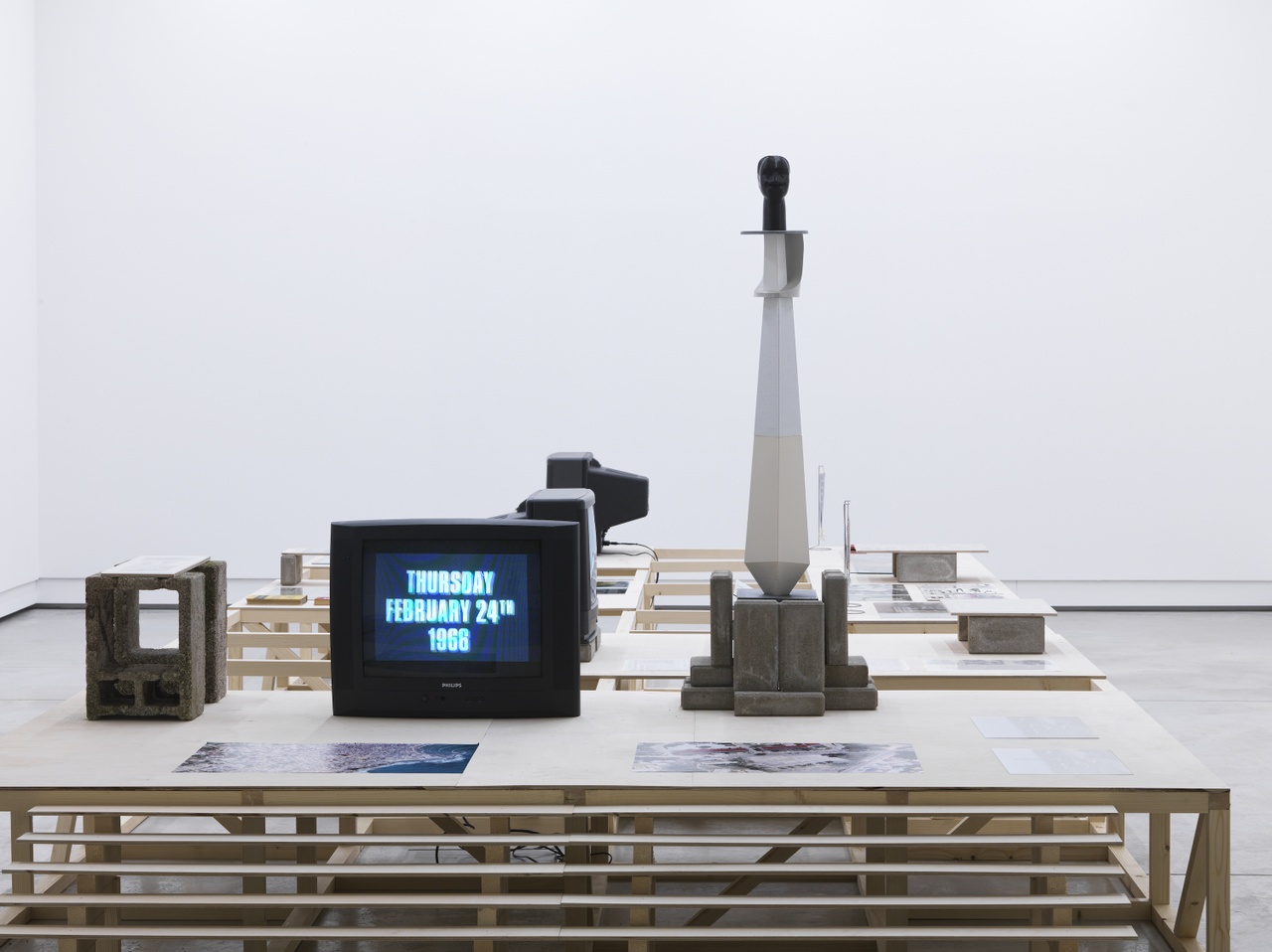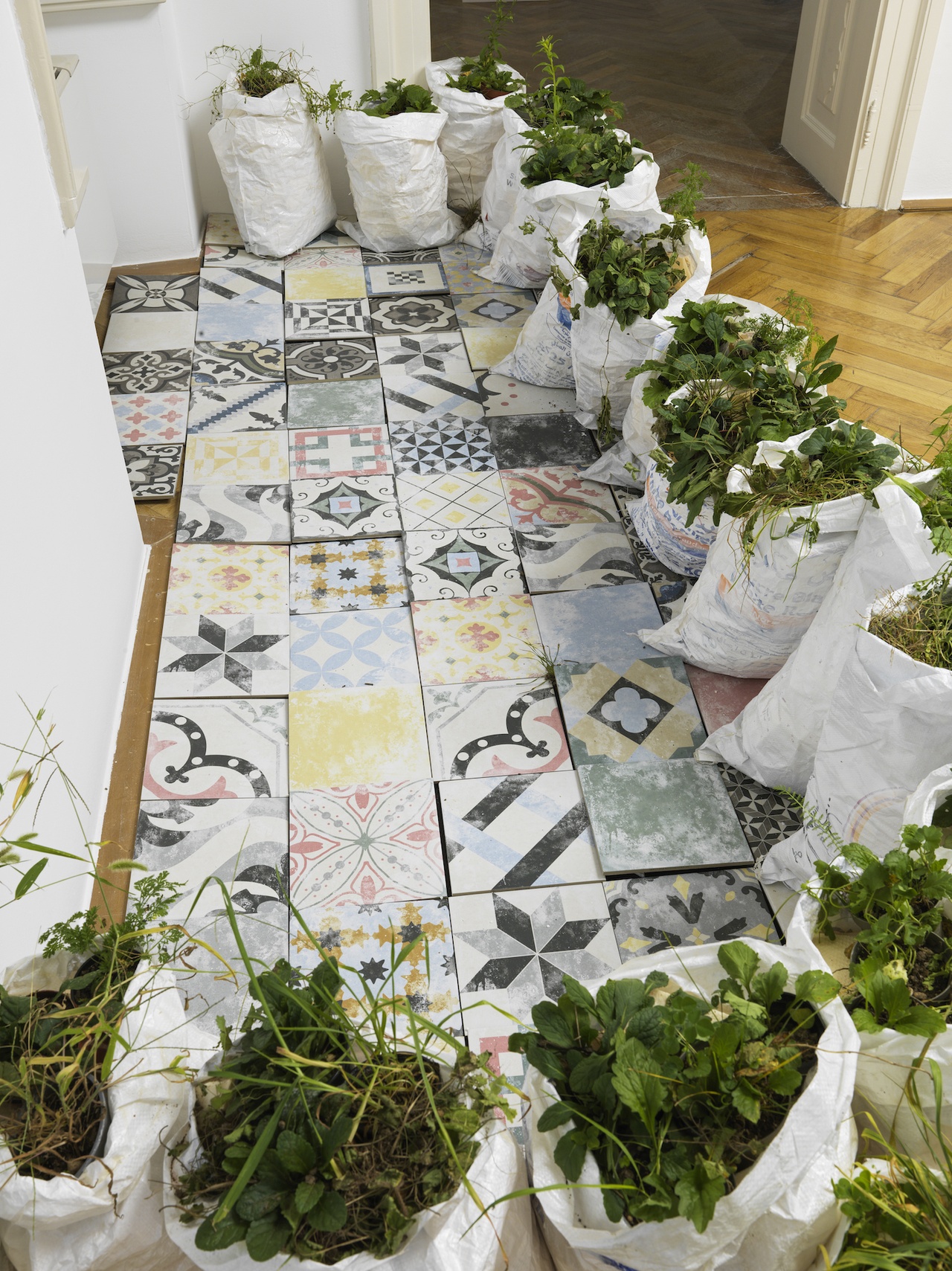SOLID STATES Xenia Benivolski on the Ljubljana Biennale of Graphic Arts

Max Cegielski and Janek Simon, “One Man Does Not Rule a Nation,” 2023
In the summer of 2023, a group of separate art shows worked together to make visible lingering cross-regional connections originating in the inception of the Non-Aligned Movement (NMA) at the 1961 Belgrade Conference that linked some of Eastern Europe to other non-Western countries. The tripartite “sister events” – the Survival Kit contemporary art festival in Riga, the Kaunas Biennial, whose cocurators collaborated under the framework of “Long-Distance Friendships,” and the Ljubljana Biennale of Graphic Arts – invited artists from Baltic and Balkan states, often in dialogue with other artists based in the Global East and South, to highlight enduring solidarities across the regions. The 35th Ljubljana Biennale, the culminating instalment of the series, is an opportunity for artists to consider the value of transnational friendships in the face of adversity and crushing neoliberalism.
The show’s curators ground their approach in three conceptual figures – the void, the gift, and the cosmos – which make up the title “From the void came gifts of the cosmos.” The curatorial collective, which includes Exit Frame Collective, Alicia Knock, Selom Koffi Kudjie, Inga Lāce, Beya Othmani, and Patrick Nii Okanta Ankrah, and the artistic director of this iteration, Ibrahim Mahama, introduced the notion of the void as a marginal yet all-enveloping space of potentiality that resists centralization, and therefore hierarchies, and instead urges the production of gifts: modes of transference without an exchange value. One such gift is the sharing of knowledge.

Jihan El-Tahri, “Threading Solidarity,” 2023
Might the refusal to participate in the relentless struggle for global hegemony put forth “potential histories as strategies to unlearn imperialism,” as Ariella Aïsha Azoulay argues, [1] helping us decipher the conditions for solidarity between nations? Cukrarna, a former sugar factory that has been turned into a contemporary art space, offers the most resolved entry point to the Biennale. A crate of cotton and a large-scale poster by Thierry Oussou entitled Equilibrium Wind (2023) depict the logo of his cotton producing businesses in the Panouignan district of Benin. First introduced to Egypt as a pervasive monoculture, cotton has been a contested fiber on the African continent – and others. In parts of the Soviet Union, for instance, cotton was a culturally significant commodity for the Soviet imperialist project, and demand for the material was utilized to justify massive violations of human rights and international laws. Some recorded history of the cotton trade between Socialist Bulgaria with parts of Africa suggests that dealers, instead of obeying the bloc bipolarity of the Cold War, followed the logic of the international markets they worked in, revealing a capitalist undertone to their socialist sentiments. [2] Now, in Benin, cotton has been reclaimed as a substance that can drive autonomous industries in places that were once oppressed by the mechanisms of its production.
Walking through the halls of the Cukrarna, Oussou tells me that to him, cotton is distinct from other commodities because all phases of its production have been historically entangled with deeply felt and storied forms of nationalized labor: from the sweat and song of picking it, to its shipping, packing, and manufacturing, and to the eventual wearing of garments. The natural fiber makes another appearance in Jihan El-Tahri’s adjacent Threading Solidarity (2023), an installation with silkscreen prints on jute and cotton muslin alongside furniture and a series of collages and archival documents. Hanging above is a bunting of portraits extracted from a photograph of the NAM leaders laughing at the 1961 Belgrade Conference, with which the artist expressly hopes to set the stage for friendship as the framing principle of political solidarity. Low to the ground, a video montage juxtaposes post-independence images of Egypt and India, and gestures to the prevalent place of the cotton industries in their postcolonial reality and continued bilateral relationship. El-Tahri’s work itself examines how national narratives, woven together, become the surfaces on which the aforementioned “potential histories” are written.

Amina Menia, “Extensions of Struggle,” 2023
Other potential histories emerge through ruins. Installed at the Švicarija (the Swiss House), Extensions of Struggle (2023) shows artist Amina Menia filling plastic bags with soil, rubble, and pieces of crumbling French colonial buildings. In Algiers, this is a common practice: jute bags filled with dirt and rubble are used to demarcate and organize public spaces, traffic, and construction areas. Weeds and invasive plants grow in the bags, forming a new ecosystem that feeds on the decaying histories within. In Ljubljana’s Bežigrajski Dvor district, a neglected construction site near the city center had originally been slated for the construction of a new Ministry of Justice building. In 2020, the site was entrusted to the Krater Collective, a terraforming entity composed of local ecologists, artists, permaculturists, and architects. Resonating with Menia’s installation, the group works with imported and invasive plant species in the abandoned urban space.
Under the general title Feral Occupations: Our labour is our infrastructure!, Krater Collective have created a number of interventions, connecting different sites in the Biennale through gentle, critical placemaking, but it’s in the abandoned “crater” in Bežigrajski Dvor that their work generates a real dialogue by exposing problematic relationships between biopolitics and the soil. Here, they established a nursing home for abandoned houseplants. Orphaned Pileas and Monsteras, bought to enliven a domestic space with a bit of exotic flair, were brought in by their owners and are now cared for by the artists. The project gestures back to the fetishization and extraction of southern flora while simultaneously making space for the migrant plants so unceremoniously discarded.
At the same location, Krater’s papermaking station mulches invasive plants into sheets of paper on which postcards are printed. These suggest that some of the revolutionary potential of printed matter lies just under the surface, in the radicality and materiality of its very substance. This is relevant context for the Biennale of Graphic Arts, which was originally created in 1955 to display works on paper, with a particular emphasis on printmaking. In the immediate aftermath of various revolutions in Africa and Eastern Europe against colonial and Soviet powers, special political agency was given to the printed word and image, which made it possible to spread vital knowledge and ideas. Some legendary printmakers who lived through those years are represented in this edition of the Biennale, such as Kagiso Patrick Mautloa working on behalf of the Bag Factory Artists’ Studios in Johannesburg, as well as Assadour Bezdikian, Sadik Kwaish Alfraji, Galle Winston Kofi Dawson, and Mohammad Omar Khalil, who presents a work in dialogue with Abed Al Kadiri which reflects on their friendship through the lens of Asilah, a Moroccan city they both frequent.

Krater Collective, “Feral Occupations: Our labour is our infrastructure!,” 2023
Tracing a direct line from the gentrification of city sites to the epistemic occupation of the Global South, the Biennale directly examines political, industrial, and cultural ties of nations that had been part of the the Eastern Bloc to Ghana, Zimbabwe, South Africa, India, and Brazil, as well as the movements they left behind, such as Pan-Africanism, Pan-Arabism, and Third Worldism. Some fragments come together in the form of researched vignettes: Max Cegielski’s and Janek Simon’s One Man Does Not Rule a Nation (2023) contains documentation of a sculpture honoring the first president of the Republic of Ghana, Kwame Nkrumah, which was crafted by the Polish sculptor Alina Ślesińska and publicly revealed in 1965 in Winneba, a coastal town in Ghana. The monument was swiftly removed the following year for political reasons. The project is meant to provoke shared values of architectural mobility [3] between Eastern European and African histories of the 1960s and 1970s, though by then some of these warm exchanges and intellectual ties had already been subverted and instrumentalized as anti-Western propaganda by the Soviet Union.
Cosmically speaking, a void is created through rupture. In Greek, kosmos designates both “world” and “order”; the Greek word for “void” is khaos, a state preceding the creation of the universe. Reflecting on the chaotic course of events that brought the utopian vision of the former Socialist Federal Republic of Yugoslavia to an end after a bloody decade of ethnically motivated fighting, Italian philosopher Giorgio Agamben wrote that this disintegration of state structures in Eastern Europe should not be construed as a resurgence of the ethno-state but “the coming to light of the state of exception.” [4] In that sense, he said, emerging political structures in Eastern Europe since the fall of Yugoslavia are not regressing to their original forms, but rather creating anticipatory events that signal the emergence of a new global order. Somewhere, in the crumbling ruins of colonization, in the gaps between warring worlds, new forms of living, thought, and solidarity are materializing.
“From the void came gifts of the cosmos,” Ljubljana Biennale of Graphic Arts, September 15, 2023–January 14, 2024.
Xenia Benivolski is a writer, curator, and educator based in Toronto. She writes about visual art, books, and music.
Image credit: 1.-3. photos Jaka Babnik / MGLC Archive; 4. photo Urska Boljkovac
Notes
| [1] | Ariella Aïsha Azoulay, Potential History: Unlearning Imperialism (New York: Verso, 2019), 21. |
| [2] | Jan Zofka, “Chairman Cotton: Socialist Bulgaria’s Cotton Trade with African Countries during the Early Cold War (1946–70),” Journal of Global History 17, no. 3 (2022), 438–56, doi:10.1017/S1740022821000280. |
| [3] | Khrushchev’s propaganda efforts in African and Asian decolonizing nations prominently bolstered and promoted Soviet assertions of its worldwide prowess in housing construction. Examples of this can be found in Łukasz Stanek’s 2020 book Architecture in Global Socialism: Eastern Europe, West Africa, and the Middle East in the Cold War (Princeton, NJ: Princeton University Press, 2020). |
| [4] | Giorgio Agamben, Homo Sacer: Sovereign Power and Bare Life (Stanford University Press, 1998), 28. |
